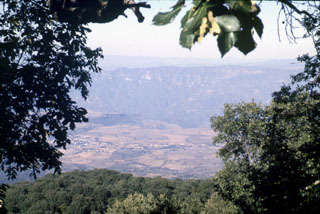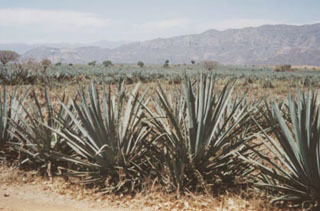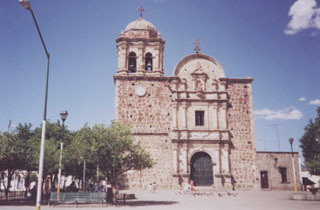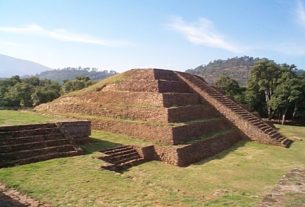The lovers of the curious will find plenty to whet their appetite (and satisfy their thirst) in the small western Mexico town of Tequila.
The town lies in the shadow of an imposing 9000 foot volcano which has the distinction of being “drive-in” by virtue of a cobblestone road built for access to the shortwave communications tower located on its rim. The ten mile drive from the town centre to the top of the volcano provides glorious views over the surrounding countryside, and an opportunity, for the biologically curious, to witness the rapid changes of flora that occur with increasing altitude. The ascent is a birdwatcher’s delight, too, with chances to see as many as 60 different bird species in a single day!

Tequila volcano is particularly unusual in that its crater has a well preserved central spine which, according to the geologically curious, most likely represents the material which solidified in the central vent of the volcano, as its activity subsided, and which was later pushed upwards by earth movements until it projected high above the floor of the crater. The classic example of a spine (and the one always quoted in geology texts) is that formed on Mount Pelee in the West Indies in 1902, which only lasted about six months before being broken down by weathering and erosion. The Tequila spine has already been around a lot longer than that, and looks well set to survive another few centuries at least.
The historically-curious will discover that the town dates from soon after the Spanish conquistadores arrived in the area, led by the barbarous Nuno de Guzman. Its name supposedly derives from “place of tricks” or “place of those who pay tribute”. Whatever the derivation, “Tequila” has become a household word around the globe ever since it became the name of that most Mexican of drinks.
TEQUILA THE DRINK
Pre Columbian Indians knew how to produce several different drinks from agave plants, but their techniques did not include distillation, and hence, strictly speaking, they did not produce “tequila”.

Fermented agave juice or “pulque” may be the oldest alcoholic drink on the continent; it is referred to in an archival Olmec text which claims that it serves as a “delight for the gods and priests”. Pulque was fermented, but not distilled. Though colonial authorities tried to suppress “illegal” liquors, the industry of illicit distilling clearly thrived. One eighteenth century list has more than 81 different mixtures, including some truly fearsomesounding concoctions such as “cock’s eye”, and “excommunication”. By the 1670’s, the authorities saw the wisdom of taxing, rather than prohibiting, liquor production.
Distilled agave juice was known for centuries as “mezcal”. By the end of the nineteenth century, tequila had assumed its present name, because of the widespread popularity of the mezcal produced in Tequila.
There are an estimated 100 million Agave tequilana plants in the area, and the approximately 40,000 hectares of cultivated agaves produce no less than 50 million litres of tequila each year. About 40% of this quantity is exported. To qualify as genuine Tequila, the drink has to be manufactured in one of two municipalities, either that of Tequila or that of Arandas to the northeast of Guadalajara. Connoisseurs argue long and loud as to which is the better product.
The agaves are started from seed or from onion-size cuttings. When the plants are mature, 8 to 12 years later, their branches are cut off, leaving the cabeza (or “pineapple”), which is the part used for juice extraction. Cabezas are cut into pieces, and then baked in stone furnaces for one to three days so that their starch is converted into sugar.
From the ovens, the now golden-brown cabezas are shredded and placed in mills which extract the juices or “mosto”. An equal amount of water is added and the mixture is allowed to ferment for several days. The spirit’s taste depends on the length of fermentation, on whether or not juice is fermented with the fibrous “bagasse” (the residue left behind after the juice is extracted), and on the design of the still.
Next time you say “Salud” with a margarita in your hand, spare a thought for the poor pre-Columbians who may have known of Tequila the volcano, but who lived in ignorance of the delights of tequila, the drink. “Salud”.
CUERVO
Having singularly failed to wipe out agave distillation by force, in 1758 the magistrate of that area of New Spain which included Tequila offered the concession to farm an extensive area near the town to Jose Antonio de Cuervo. The Cuervo family is still very active in the town today. The first commercial distillery was begun in 1785 by Pedro Sanchez de Tagle. Many other concessions were granted in the next fifty years.
During the 1880’s, as the railroads expanded, the reputation of Tequila spread further afield, until not only did the “mezcal of Tequila” became, simply, “Tequila” but the drink also became adopted as the national drink of the entire country.

Today, visitors to the town can not only enter a tequila factory to watch the processing and acquire a sample but can also admire one of the few monuments to liquor anywhere in the world a fountain which has water emerging from a stone bottle supported in an agave plant.
Tequila is only an hour’s drive from Guadalajara along highway 15, the main highway to Tepic. If staying in Guadalajara, your hotel will be able to arrange for transportation to Tequila; your taxi driver will be more than happy to wait while you explore the town but make sure he doesn’t try to sample the local brews before he’s got you safely back to your hotel!
A rented car is a better option if you wish to drive up to the rim of Tequila volcano. The road leaves the town near the railway station ask for directions in the centre of town. Allow at least forty-five minutes driving time each way and plenty of time for photo stops.
Any time of year is good for visiting the town but, if you can, why not try to visit during the Tequila fair held annually from the end of November to mid December? Alternatively, consider timing your visit to coincide with May 13th the “Day to feast Tequila” “Salud!”



